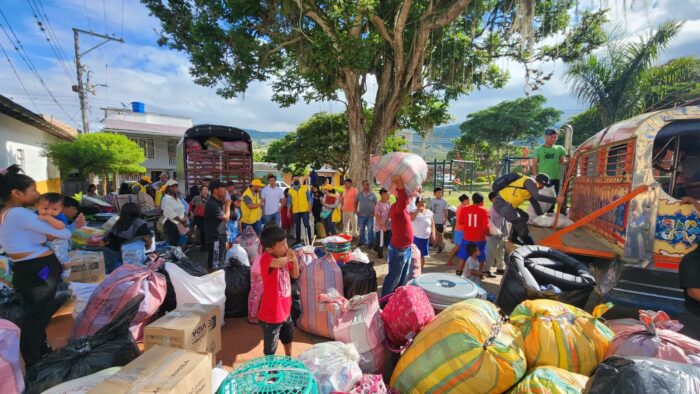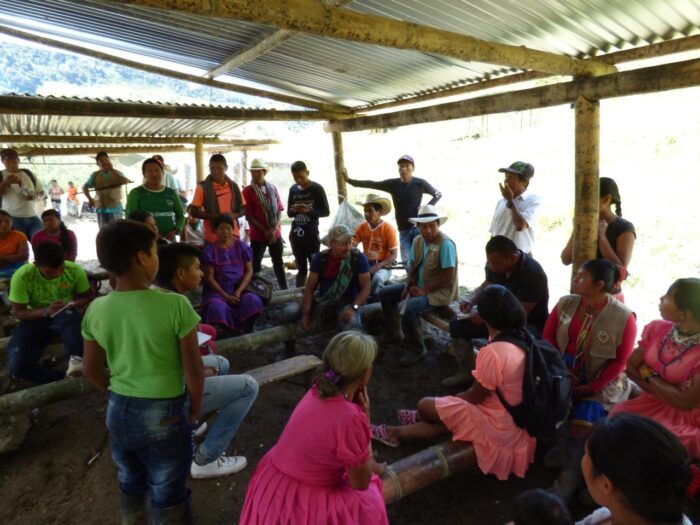Grace Livingstone speaks to the two governors of this Emberá Chamí community and the director of the Valle del Cauca land restitution authority to learn more about the case, and analyses the current government’s efforts to tackle displacement and land reform.
An Indigenous community has won a significant legal victory in Colombia, giving them the right to return to their lands after being displaced by armed groups. The historic judgement has raised hopes that Colombia’s land restitution programme, which stalled under the presidency of rightwinger Ivan Duque, is finally starting to deliver justice for victims.
330 families of the Emberá Chamí ethnicity lived in an autonomous Indigenous territory in the Río Garrapatas canyon in Valle del Cauca, southern Colombia, but suffered years of violence from rightwing paramilitaries and their successors, as well as from dissident leftwing guerrilla groups and the Colombian armed forces. Killings, kidnappings, disappearances, threats, and forced recruitment obliged the community to abandon their lands. Since June 2023, 1,500 members of the Emberá Chamí community have been camped in makeshift shelters in the town square of El Dovio, demanding justice.
But in a wide-ranging judgement last month, a court which was established as part of the government’s land restitution scheme ruled that the community had a right to return. It also ordered the army to make a formal public apology to the community on behalf of the Colombian state and banned both the police and army from carrying out military actions within their Indigenous territory. The ruling also prohibits Colombia’s anti-narcotic authorities from aerially spraying herbicides on their lands and states that mining concessions cannot be granted within their territory without their consent. It also enshrines the community’s right to a healthy environment and food security.
‘This is a historic ruling because it recognises the collective, territorial, cultural, and spiritual rights of this community’ says Luis Gabriel Rodriguez, the director of the land restitution authority in Valle del Cauca. Gabriel Rodríguez says it shows the political will of the new government to implement land restitution, pointing to a similar judgement in Valle del Cauca last year, which has enabled the Wounaan Nonam Indigenous community of Santa Rosa de Guayacán to regain their lands. The Wounaan Nonam community returned to their territory near the Pacific coast last December, accompanied by the land restitution authorities.

But displaced communities in Colombia face long-term difficulties, often establishing new lives when they move. The two governors of the Emberá Chamí community in Valle del Cauca, Mario Guaquerama and Robinson Gutiérrez Niaza spoke to Latin America Bureau. They said they were very pleased with the judgement and immensely grateful to the judges, the land restitution authorities, and the government. However, the community is debating whether to return. Their resguardo [reserve] is 8 to 10 hours walk from the nearest town, and lacks services like healthcare, education, and roads – a legacy of years of neglect. They are currently talking to the authorities about how best to create viable lives for the community, for example by increasing the size of the resguardo so their lands are nearer local services and markets.
Colombia has the highest rate of internal displacement in the world after Syria. According to the government’s register of victims, 8.6 million people have been displaced in Colombia. The land restitution law came into force in 2011, following years of campaigning by displaced peoples and human rights organisations. It was a precursor to the 2016 peace accords, signed by President Juan Manuel Santos with Colombia’s largest guerrilla group, the FARC, which committed the Colombian state to far-reaching agrarian and socio-economic reforms.
However, in 2018, Ivan Duque, a rightwinger and critic of the peace process, became president, stalling hopes of land redistribution and justice for the displaced. On the ground, armed groups including former paramilitaries, often working on behalf of landowners, threatened people trying to return, as well as employees of the land restitution authority: between 2011-2020, 48 land claimants and 10 police officers accompanying land restitution teams were killed.
Leftwinger Gustavo Petro came to office in 2022, promising to implement the peace accords and resettle displaced people. Since his government came to office 20 months ago, it has speeded up land restitution judgments and more than 10,808 people have received court rulings re-instating their land rights (compared with 2,800 a year during the previous 11 years under other governments).
Overall, since the land restitution law came into force in 2011, over 42,500 individuals have won the right to return to their lands, covering a total 247,000 hectares (2,470 square km). In addition, 31 Indigenous and Afro-Colombian communities have won land restitution judgements, comprising more than 52,700 people. Despite these rulings, not all of these people have chosen to return to their original lands for a variety of reasons.
One problem is that violence by former paramilitaries, criminal gangs, and dissident guerrilla groups continues. This prevents people from returning to their territories and continues to force people from their homes.

Last year, the number of people forcibly displaced was 146,049, an 18 percent rise on the year before. In some regions, the increase was far higher, for example displacement rose by 54 percent in Cauca, in western Colombia, and by over 1,000 percent in the southern department of Putumayo, according to Colombia government figures. The incidences of forced mass collective displacement – in which entire communities are forced to flee their homes – also rose last year by 7 percent. In 2023, 54,665 people were affected. (These figures are in addition to the individual displacement cases cited above).
By far the worst affected region was Nariño in western Colombia, where an armed group made of former paramilitaries, Autodefensas Unidas de Nariño, is vying for territorial control with the leftwing guerrilla organisation the Ejercito de Liberación Nacional (ELN) and dissident blocs from the demobilised Fuerzas Armadas Revolucionarias de Colombia (FARC). Last year there were 58 incidences of mass forced displacement in Nariño affecting 23,483 people. In this same western region of Colombia, the departments of Chocó, Valle del Cauca, and Cauca also suffered high rates of forced mass displacement.
In an effort to stem the violence, Petro’s government negotiated a six-month ceasefire with five of the largest armed groups last December, including the ELN, two FARC dissident groups, and a large dissident group of former paramilitaries, but these ceasefires have been repeatedly broken.
At the root of Colombia’s decades-long conflict is land inequality. As well as trying to tackle displacement, Petro’s government is also committed to agrarian reform. It aims to redistribute 7 million hectares of land by the end of his administration. The government plans to buy 1.5 million hectares of unused land to distribute to small farmers and communities (although this has been downgraded from an original plan to buy 3 million). It is also re-allocating land confiscated from illegal armed groups and is formalizing the land titles of people who have been working the same plot of land for generations. By the end of 2023, it had formalized 1.3 million hectares according to the Colombian land agency, although it has inherited an enormous backlog, and there are still 37,000 land titling cases outstanding.
Decades of conflict have forced several other Emberá communities to move to cities across Colombia, where they struggle to live with dignity. This historic judgement suggests that the Petro government has the political will to address displacement but the task it faces is huge – ongoing violence by armed groups and historic structural inequalities in the distribution of wealth, power, and land.
Grace Livingstone is a journalist and academic. She is the author of several books including America’s Backyard: the United States and Latin America from the Monroe Doctrine to the War on Terror.
Main image: Emberá Chamí Community. Photo: Unidad de Restitución de Tierras

